Finished!
I’m very happy with it.
Have you ever abstracted something like this? I like the effect. What do you think?
Ellen Lindner

Finished!
I’m very happy with it.
Have you ever abstracted something like this? I like the effect. What do you think?
Ellen Lindner
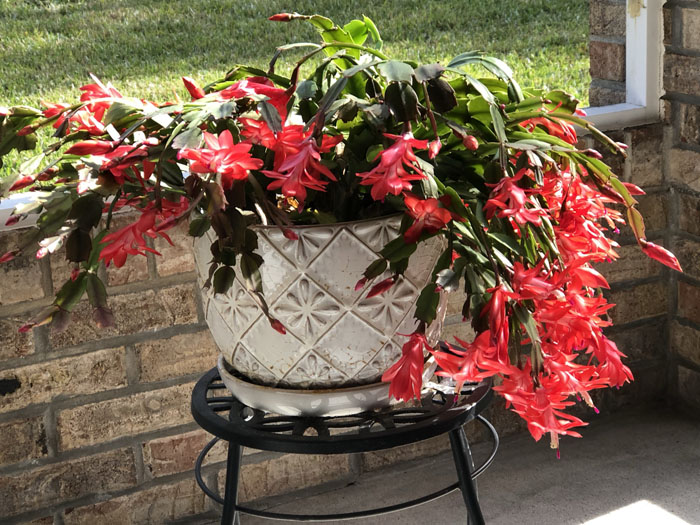
After studying my photo of a Christmas cactus, I decided to try abstracting it with one repeated shape. Maybe something like these “spike” shapes. 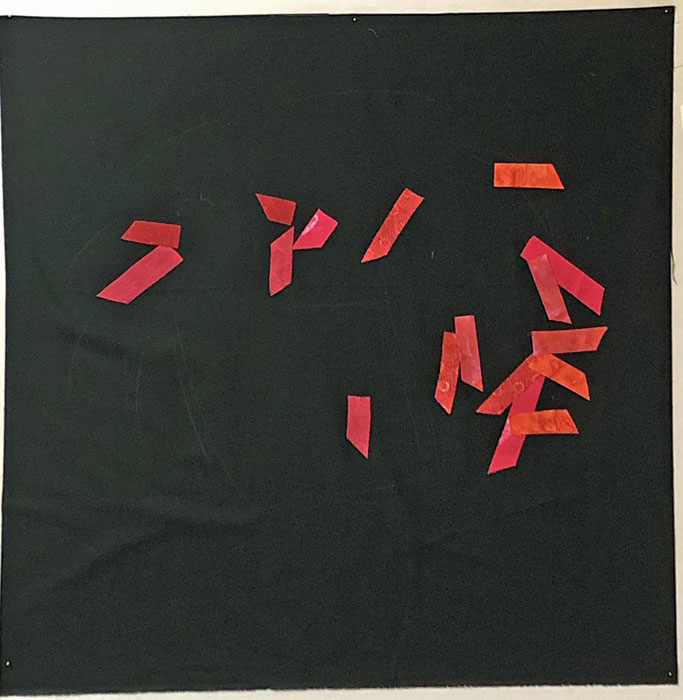
Yes, I thought they worked well.
My original idea was to fill the entire space with this shape, just changing the color for background grass, brick, etc. But, when I tried that for grass I didn’t like it at all. Especially since just a few shapes were so effective.
So, I decided to depict the actual plant only.
Here it’s shown as a square. I thought it would probably be better if I cropped off some of the left area.
From there things fell together easily. Here it is, well under way.
I was loving how it was coming together and I didn’t want to over work it. Audition. Edit. Repeat.
I think I’ll have this one finished quickly. Stay tuned.
Ellen Lindner
P.S. I’m not sure how to quilt the background. I’ll have to give that a good bit of thought.
Once again, my Christmas cactus was beautiful this year. (Here in Florida it lives outside year round.)
I began to imagine what an abstracted version might look like in fabric. Can’t you envision some bright, spiky red shapes? I was especially enamored with the cascading blossoms on the right side.
Just to jump start some ideas, I played with the photo on my computer. This pointillist version really got my attention.
Whoa! I was pretty much blown away by these bright spots of color and the black background.
I began to ask questions and to make plans. I knew I wanted to include some black and to use shards of bright colors. I didn’t think I wanted to use little circular blobs, though.
What would be a better shape? Maybe a rectangle with a point cut off? (A shape I had just used in my most recent quilt.) Would I want to cover the entire surface with such shapes? I didn’t think so.
I bought some solid black fabric and began to audition colors and shapes. I’ll show you soon.
Ellen Lindner
Last month I taught three classes for Road at Home, a large quilt show type online event. The first was the ever popular Double Reverse Appliqué. We had fun and the students did excellent work!
First I’ll show you Cindy’s apple, because she was my college roommate! How cool is that? She lives in Minnesota and I’m in Florida, so this was rare interaction. She’s very new to art quilting, but she had no trouble at all.
Trudy’s bright colors pop nicely! 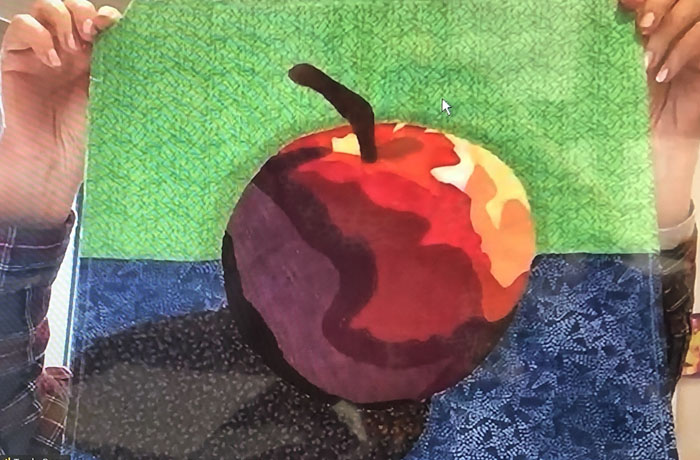
Susan used more muted colors, which gave a completely different effect. (These photos are via Zoom, so the stripey computer effect isn’t really there on her fabrics.)
Kami made very bright and colorful choices!
Of course, not everyone chose a red apple. Doesn’t Chris’ green one look great? And the purple background color is perfect!
Irene’s green apple was almost complete. (Yes, we do the background last with this technique.)
Keitha’s near-solid fabrics really let the value changes do the work. This is what makes it look 3D.
C.J. won a free seat in class and put it to good use. I love the way her apple stands out against her blue-green background fabrics.
Bonnie worked all day with power from a generator. That was a new one for me. As you can see, it didn’t slow her down at all. Nice, right?
Grace missed a large part of the day but still managed to make a good start on her apple.
The class also includes a pattern for a pear. After finishing their apples a couple of students made a good start on their pears. Check out Kami’s BRIGHT colors.
And Cindy made good progress on a gold pear. We worked from light to dark, so we started with the highlight spots: not too exciting. It doesn’t look much like fruit until after about 8 pieces are added.
Another fun and productive class!
Ellen Lindner
P.S. Would your guild like this class? Find out more here.
The supply list for my class, Design Your Own Nature Quilt, includes artistic couraage, and the ladies in Venice, FL brought it in spades! During our two day class they didn’t even whimper. 😉 But, they DID make some extraordinary quilts.
Let’s start with Helen, who was taking her first ever quilt class. (These images were taken at the end of class, as seen on my computer screen.)
Didn’t she do a great job? Everything is constructed onto a muslin base. Helen has decided to preserve the raggedy uneven edge of her composition, so she’ll tuck her border fabric(s) under the edge of the composition fabrics, where they’ll also be supported by the muslin.
Joan C. rearranged her flowers and cropped the composition to get a really pleasing arrangement. And, after a brief consultation, she had the skills she needed to make a second piece in the next few days. I love that!
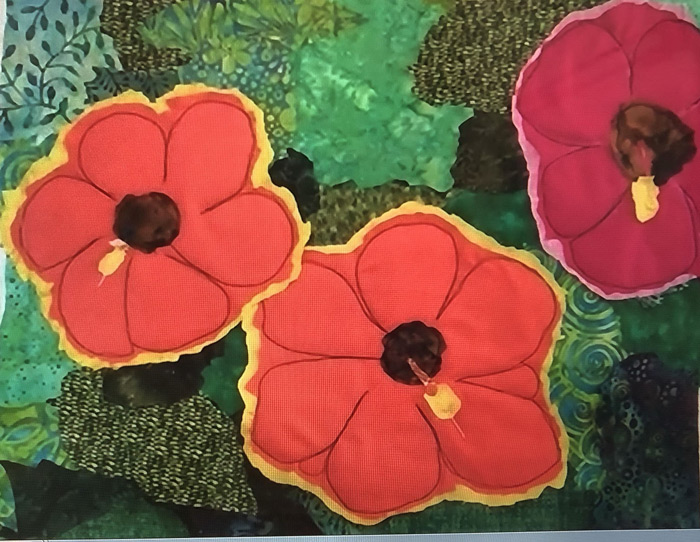
Elaine’s poppies live up to their name, since they seem to pop off the background! Her inspiration photo had MANY more flowers in it, but she wisely edited it down to just a few. This gave her the ability to enlarge them and show them off. And what about that black stitching? Doesn’t it add wonderful detail?
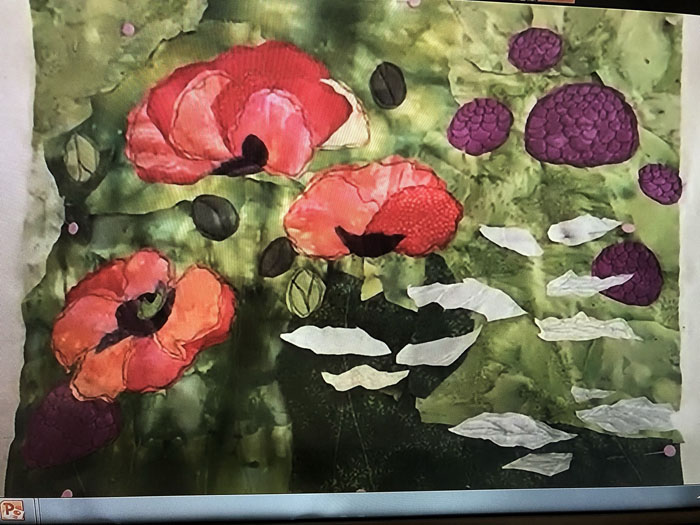
Joan D. depicted the best parts of several photos of sea grape leaves. She created tiny lines by adding slits to her leaf fabrics, so the underneath vein fabric could show. Here she’s auditioning the position of the sea grapes. I think she’s about got it.
Did you notice Joan’s background fabric above? No? Good. That means it did it’s job of showing off the leaves. Brava!
Teaching via computer means I can’t easily see the student’s quilts as they’re working. There are ways for them to show me, but if they’re confidently working away, I don’t ask to see their progress. Such was the case with Nancy. Therefore, I was floored when she showed us this at the end of day one. She did a great job of playing up the contrast and adding depth.
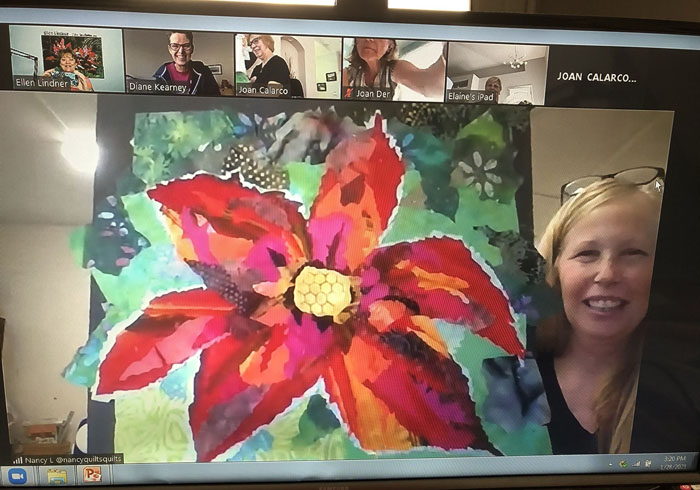
Then, on day two, she did this. Whoa, Nancy, you’re making me look good!
Unfortunately, I didn’t get a photo of Pat’s project. She had a lively yellow flower well underway.
I always say that this is my favorite class to teach because the students learn so much. That definitely held true with this group and I’m itching to teach it again! (Hint, hint: here’s the info if you think your guild might be interested.)
Ellen Lindner, proud teacher
I’m really happy with my latest quilt, Water Dance.
I wanted a lot of energy in the piece, and I think I achieved it.
The detail shot shows how I added double black stitching for emphasis. I use this technique quite a bit and I think it’s effective. I always do it in a rather loose sketchy sort of way.
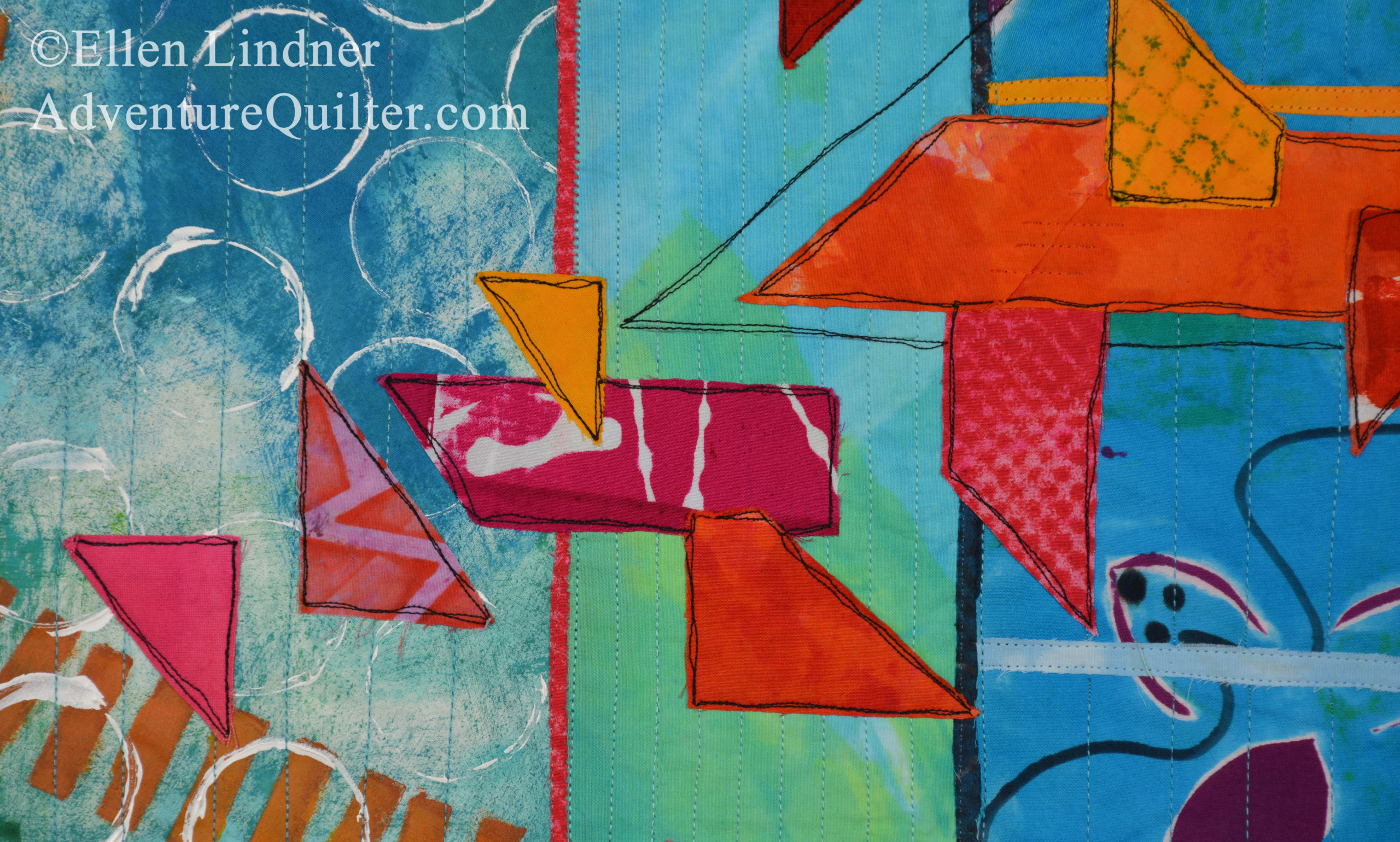
For this quilt I used exclusively fabrics that I dyed myself.
See more information about Water Dance here. And see it in progress here and here.
Ellen Lindner
You probably know about English paper piecing. It’s a way to use hand stitching to create very precise patterns. Each piece of fabric is first stitched around paper or cardboard. Later, the shapes are stitched to one another and, finally, the paper is removed. (Check out You Tube for a PLETHORA of different ways to do the stitching.)
Years ago I decided I needed a hand sewing project, so I made a bunch of 1″ hexagons. Or “hexies” as they’re called in English Paper Piecing (EPP) lingo. Mine are the 1″ size, which is the length of each side.
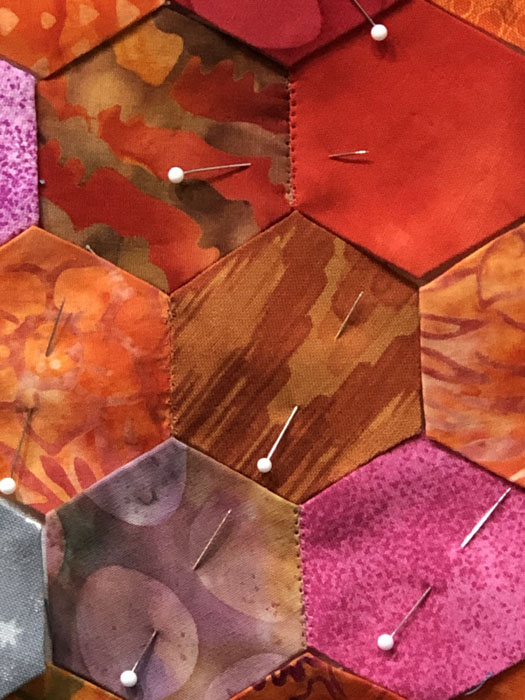
Any EPP purist would probably gasp if they looked closely at the image above. It clearly shows that I’ve used machine stitching to join my hexies. NOT the norm! But, more about that in a minute.
As I said, I already had a bunch of hexies, so when Linda Kemshall, of DesignMattersTV.com talked about making them, I got reinspired.
This shows a bunch of hexies ready to be stitchied. My card stock templates have a hole in the middle which serves two purposes. 1 – it givse me a way to secure the fabric to the template, with pins. 2 – it makes it easier to remove the template later because I can pop a pencil in there and easily pry it out.
After hand stitching and ironing the hexies, they look like this. The ironing is done with the template still in place. Aren’t they lovely?
This is what they look like from the back. Apparently, you’re not supposed to remove the templates before joining them to adjacent pieces. But, I didn’t know that.
I tried hand stitching them to one another and I was NOT good at it! My stitches were quite visible from the front. (Would those templates have helped here, I wonder?) Since I wasn’t too keen on that much hand stitching anyway, I decided I could sew them to a muslin backing and use a clear thread and a zigzag stitch to attach them. So that’s what I’ve been doing.
I’m really loving the effect of these gently undulating colors. I don’t have a color scheme in mind, although I seem to be leaning toward orange. I will pay attention to brightness, however, and use fabrics that aren’t too loud.
I expect this to be an ongoing pick-it-up-when-I-want-something-portable type of project, rather than something I complete all at once. At any rate, I’m having fun.
This link shows how I make my hexies.
What’s your favorite portable project?
Ellen Lindner
P.S. YouTube has a ton of other videos about making and joining hexies.
P.P.S. Update: when searching for similar posts I found one showing that I had used this same method before. That link is below.
After a disappointing attempt at making a quilt featuring my large-scaled hand dyed fabrics, I dramatically down sized and tried again.
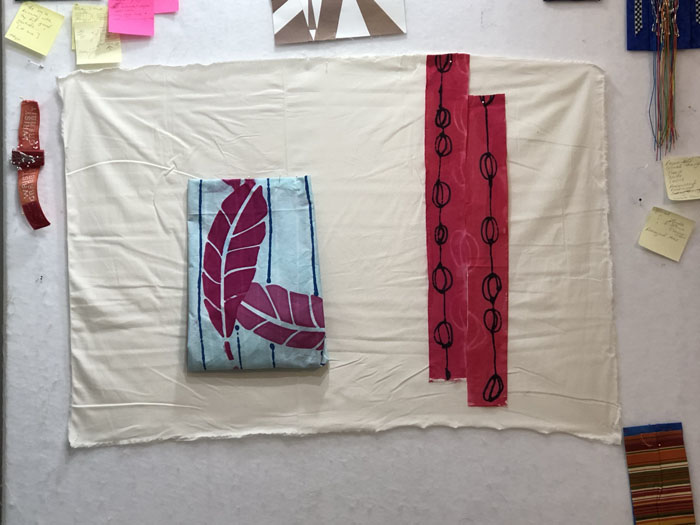
This time I switched the color proportions, using turquoise as my primary color and fuchsia as the accent. I still found it hard to incorporate the leaf fabric. Maybe because it had a lighter background? As you can see, I quickly over worked it.
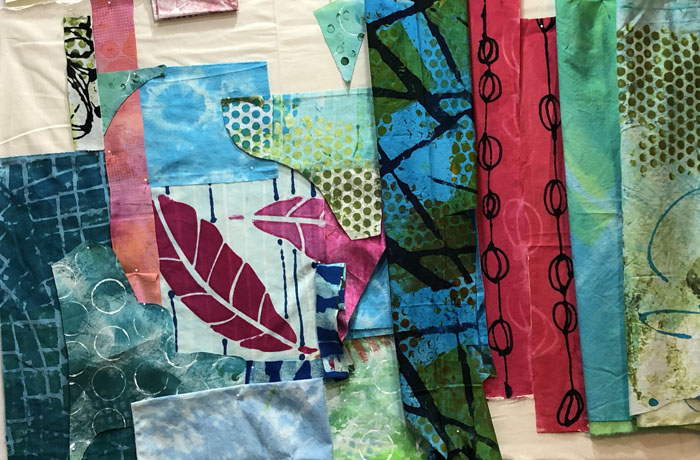
Have you heard the saying, “If something’s not working out (visually) remove your favorite thing?” Yeah. I slowly considered that I might need to remove the fuchsia leaf fabric and eventually did so, (reluctantly.) And, of course, things got much easier after that.
The background progressed well and I was very happy with it. It even showed off my fabrics, right?
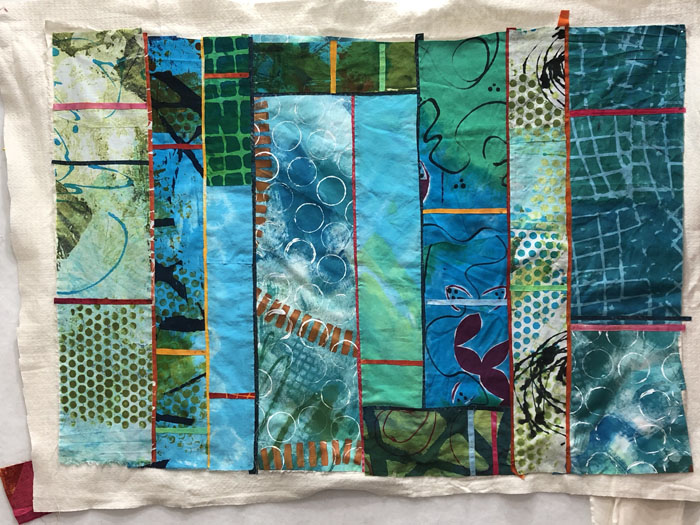
On to a focal point. And I had the perfect specialty fabric for it.
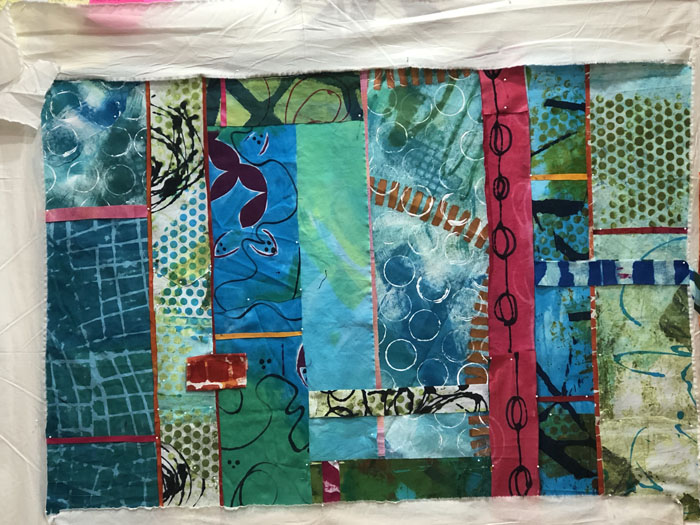
But one strip of perfect fabric clearly couldn’t carry the whole piece. I knew I’d have to cut it into pieces to add some energy and to improve the composition.
BTW, I’m calling this “The robbing Peter to Pay Paul photo.” It shows what’s left of the original composition on the left design wall, as I reworked it on the right, using many of the previously cut fabrics.
OK, so I needed to mix things up a little. I decided to expand the color palette and to add additional smallish pieces. A quick audition confirmed this as the correct direction. Didn’t it gain a lot of energy from that?
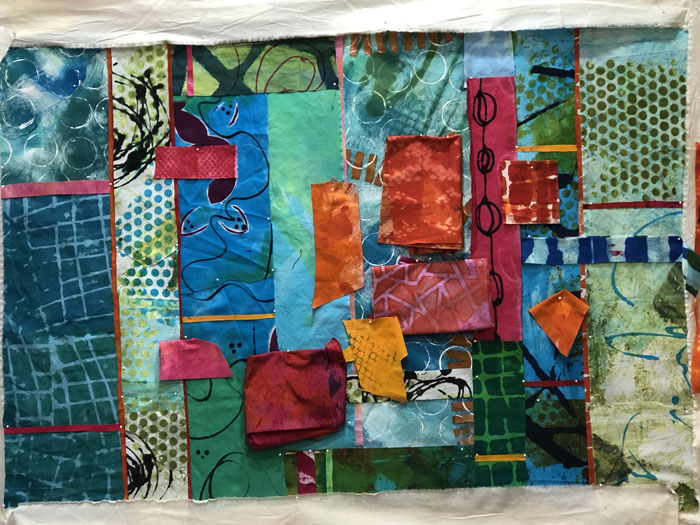
I committed to cutting smaller shapes and I was really liking where this was going.
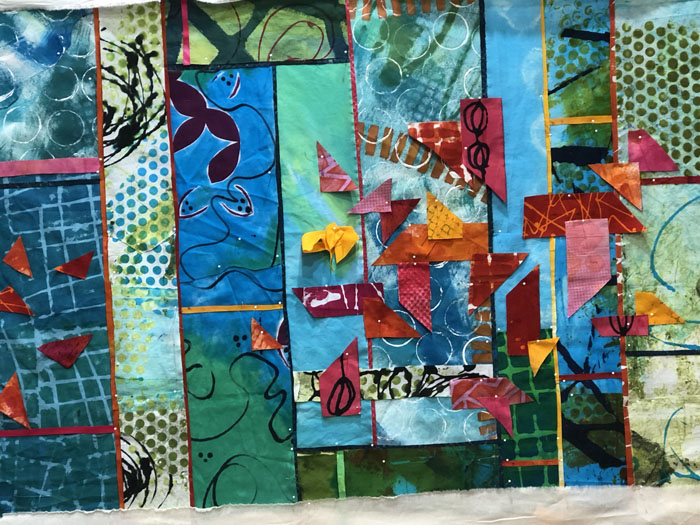
I was getting close. After finalizing the arrangement, I took lots of photos of the accent pieces and lifted them all off. Then I quilted the background with straight lines. At one point I put the background back on the design wall, but accidentally got it upside down (below.) I decided I liked that better.
Here’s the final arrangement pinned, and ready for gluing, then stitching/quilting.
I’ve had quite a time thinking of a name. Any suggestions? I’m leaning toward Underwater Dance, Shallow Water Dance, or just Water Dance. Do you think any of those work?
Ellen Lindner
P.S. Don’t you love my new lights on my design walls? I LOVE them!!! (See more of my recent studio revamp on my video page.)
As I mentioned in an earlier post, a specialty fabric or two can be the primary inspiration for an entire quilt. And that’s what I wanted to try.
This is sort of what I had in mind. I had intentionally dyed some large scale fabrics in order to try my hand at this. Plus, I had a few from earlier dye sessions. I thought I could do something with these, keeping the large scale pieces more or less intact, so their designs would still show.
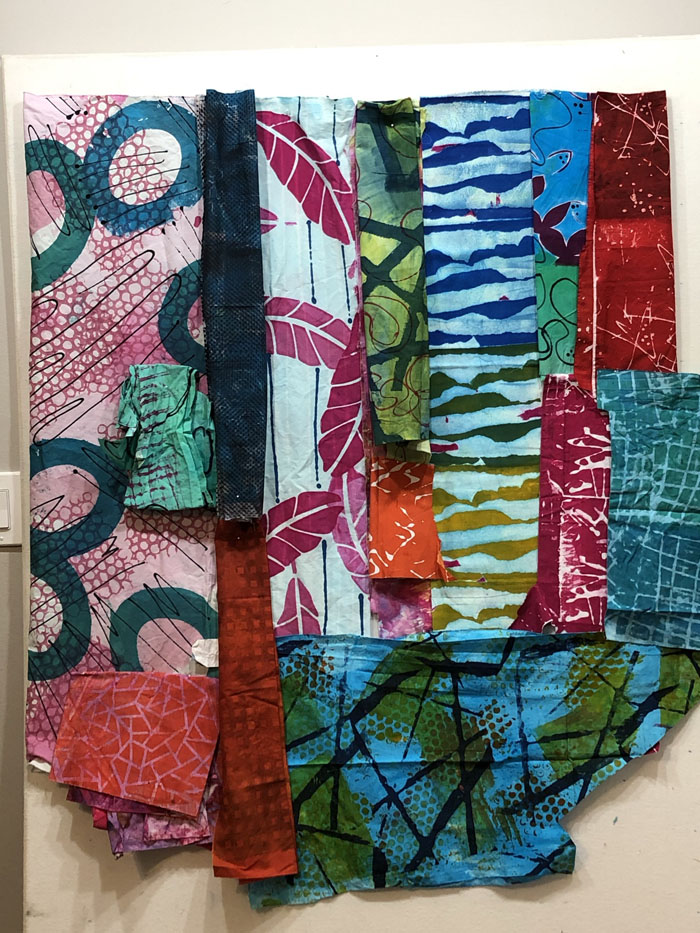
I put my muslin support fabric up on my design wall (nearly 4′ x 5′) and started auditioning fabrics. I almost immediately removed the large circles from the mix since I thought the colors looked a little muddy.
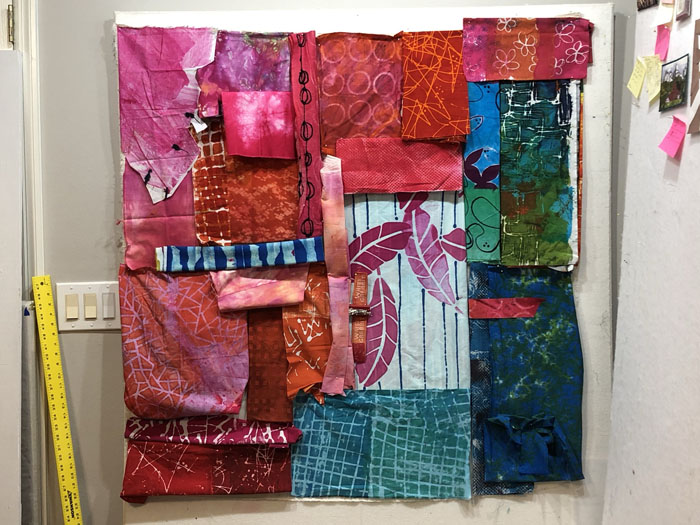
Hmm. I could see that the light blue fabric with fuchsia leaves was standing out A LOT. What to do? (Note that all fabrics are just folded and pinned in place at this point.)
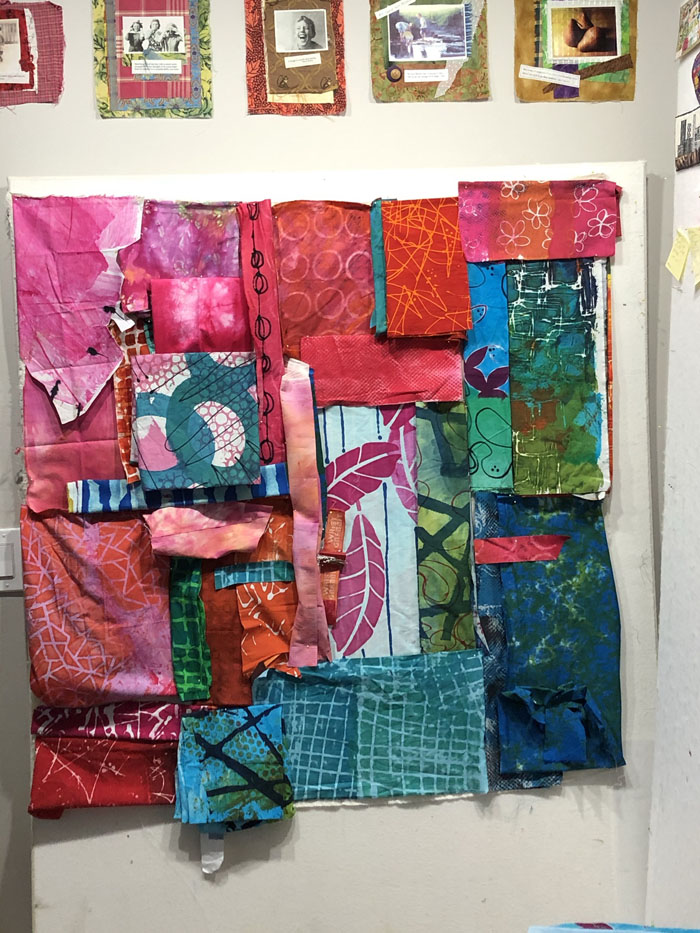
I made the highlight fabric smaller. And, of course, added the circles back. (Can you say “trial and error?)
I was loving the colors, but the composition was definitely lacking. I thought it needed some variety of scale, so I made some small units with scraps. (These are just glued to one another.)
Well, they look pretty exciting don’t they? But, how to best use them?
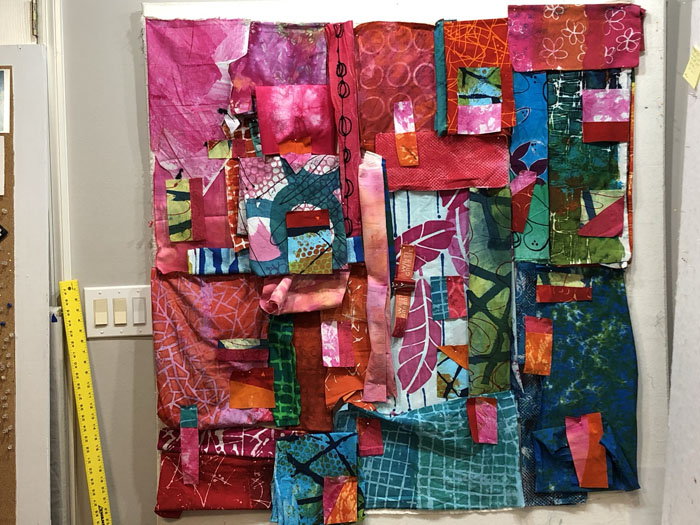
Those little pieces definitely added energy, but everything was looking pretty messy at this point. I decided I needed to commit to CUTTING fabrics, so I could see it all better.
Which is when I realized I had gotten way off track.
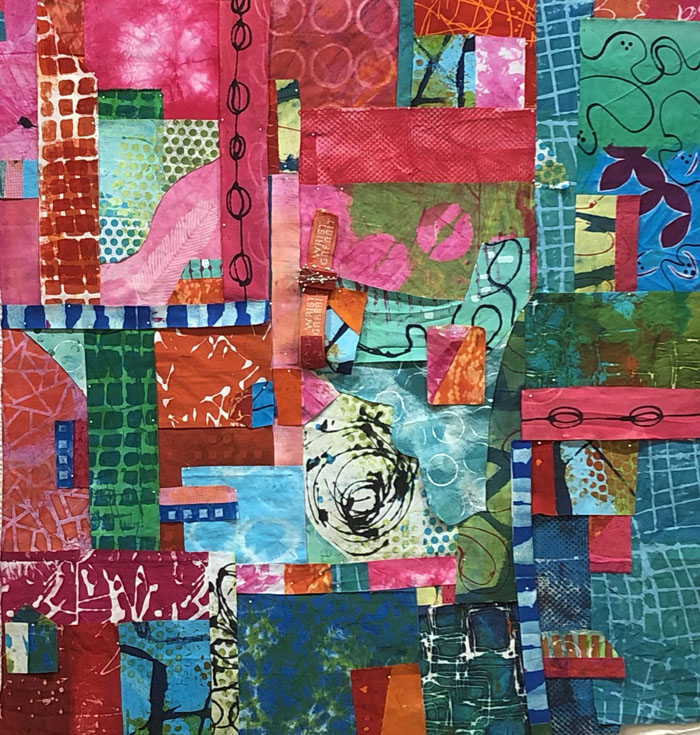
I was loving the colors, but I was having a terrible time using those large scale prints. Finally, I decided that my fabrics just weren’t large enough for this size quilt.
So, I started again, at about one quarter the original size.
I could immediately see that this was much more viable. On to round two.
BTW, I don’t fret when I have to rework something. Each “detour,” as I call them, has value. I learn from them. Typically, I’m excited to use that new knowledge as I plow ahead into the next thing.
How do you react to restarts?
Ellen Lindner
Dying specialty fabrics is a lot of fun. Having said that, I don’t think I’m that good at it. And I DEFINITELY am challenged when it comes to using them.
But, I’m getting ahead of myself.
During my recent dye session I tried to create some specialty fabrics that could either be used together or that could be used as “anchor” fabrics for a quilt.
Like these two.
I was hoping to use them together. These are each 45″ high, so you can see that the scale is pretty large. I was excited about trying them.
I thought this one could be a good anchor fabric. The motifs are smaller, so it will work more like yardage – but not entirely.
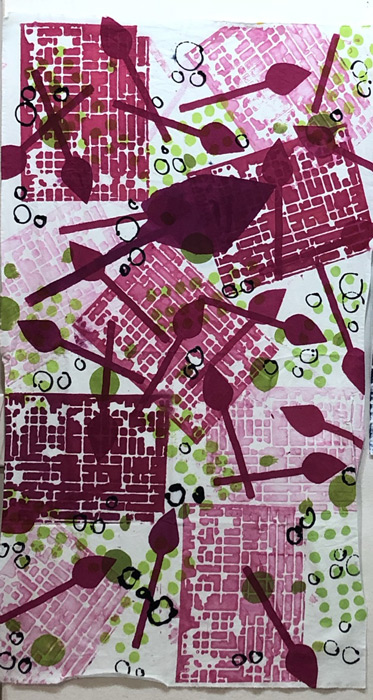
I sorta love this blue/green one, below, on the left. It has the feel of yardage, but the large scale “spades” make it less so.
The one on the right looked better when it was wet. The yellow/gold background was much darker and richer. Maybe it will need some over dying down the road.
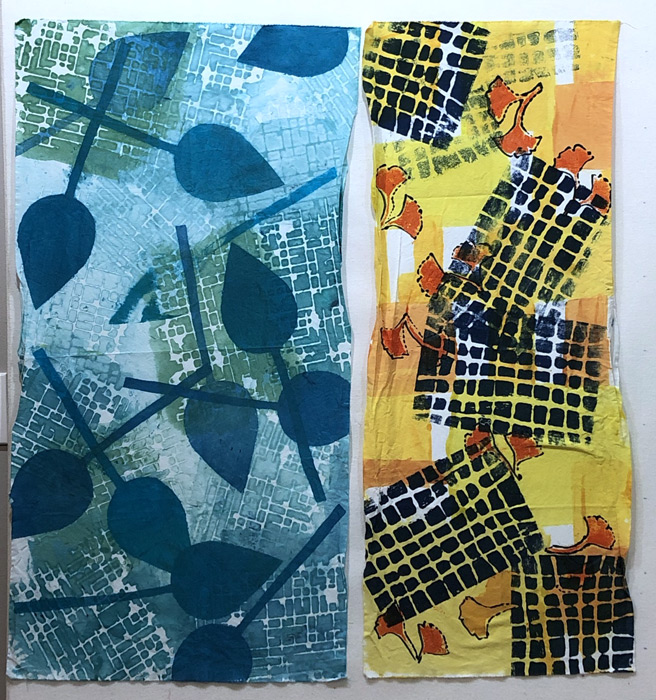
This fabric was made with something new to me: a mask. A mask is similar to a stencil, but the pattern doesn’t extend all the way to what would be the corners of a printing screen. Which means I didn’t want to screen print with it, because I’d get bit rectangles of color, with the delicate design masked out. Instead, I applied the dye loosely with the sponge. This allowed me to merge one color into another.
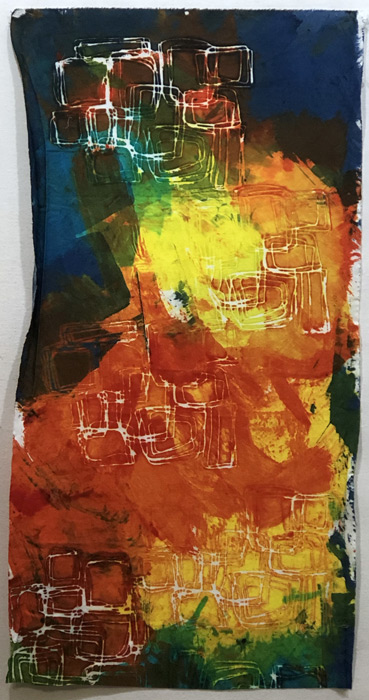
As you can see, I wasn’t careful about preserving the masked designs. Instead, I sponged over some of them with a later color. This gave interesting results. See what I mean in the detail shot below.
I was delighted with the results and will definitely play around with masks some more.
Ellen Lindner
P.S. Do you have tips on working with masks? I’d love to hear them.